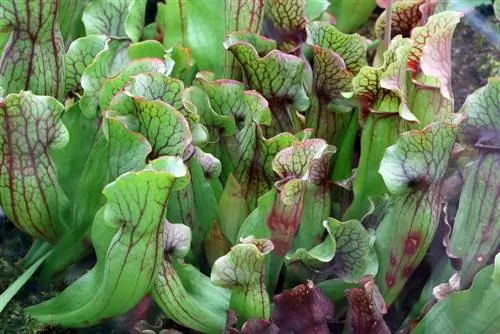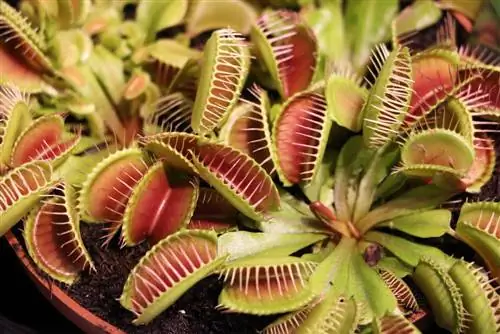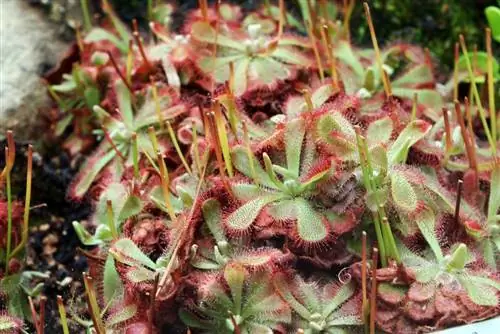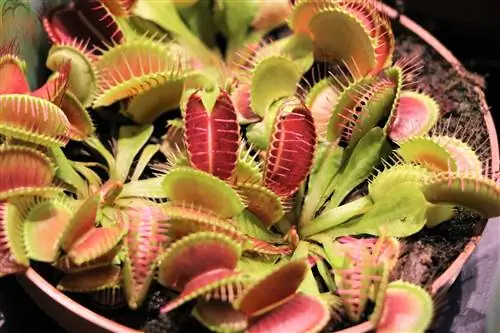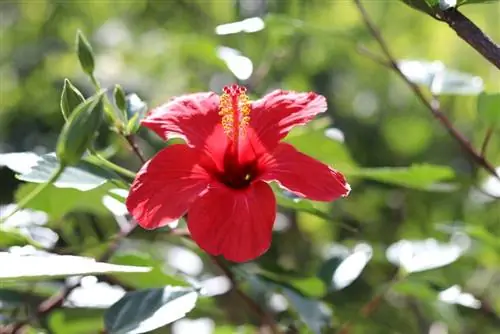- Author admin [email protected].
- Public 2023-12-17 03:39.
- Last modified 2025-01-24 12:45.
Nature's lavish bounty has produced some extraordinary plants. The carnivores are undoubtedly one of them. Admittedly, they don't always look impressive on the outside. But they are different from all other plants in one thing: they like meat! Do they also act strangely in other things? For example, when winter is approaching: do you need a digestive sleep? Or even a vegan diet?
Species and climatic origin
Carnivorous plants, also called carnivores, carnivores or insectivores, come in numerous species and varieties. They are not all directly related to each other, rather they can be found within other plant orders. Their distribution also extends across several continents and touches different climate zones. They also differ in their requirements for living conditions and care requirements.
When it comes to overwintering, a generalization is not possible. Not all carnivorous plants need a break in winter and they vary widely in terms of winter hardiness. Therefore, clarify which area your carnivorous plant comes from and which genus it belongs to. Your requirements in the cold season usually depend on this. If in doubt, it is better to overwinter them protected from frost. The common species that we cultivate are described in more detail below with regard to their winter requirements.
Venus flytrap
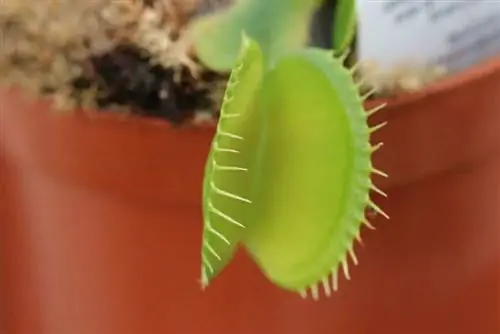
She is the undisputed star among carnivores. Their trapping leaves snap shut in a matter of seconds and the insect is trapped. A spectacle that apparently fascinates many people because the demand for it is great. Its homeland is in the USA, North and South Carolina as well as Florida, where it has different climatic conditions than in Northern and Central Europe. In its homeland it grows in the wild, here it is kept as a pot plant.
Rest needs
The Venus flytrap is only hardy to a limited extent, so it begins a longer period of rest in autumn. To recognize when it needs rest, you don't need to look at the calendar, the Venus flytrap gives clear signals itself.
- It forms very small leaves
- she doesn't open her leaves
- the inside of the leaves no longer turns red
If you notice these signs, it's time to give it suitable winter quarters until April. Beforehand, the above-ground parts are cut off so that they cannot get moldy.
Note:
Young plants should not hibernate in the first two years
Winter quarters
This carnivore has certain requirements for optimal winter quarters. It should have the following properties:
- no major fluctuations in room temperature
- constant temperatures of 5 to 10 degrees Celsius
- very bright
- free from drafts
Suitable accommodation could be:
- Basement rooms with large windows that let in plenty of light
- light-flooded attics
- unheated stairwells
Winter Care
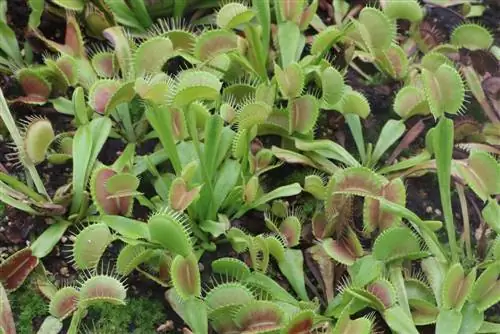
Only minimal basic care needs to be maintained during their rest period. During this time it requires no fertilizer at all and only a little water. Watering can be moderate every two to three weeks. Waterlogging should never form. The coaster must be emptied promptly if water has collected in it.
Wintering in the refrigerator
If there is no suitable winter quarters that meet all of the aforementioned conditions, the refrigerator is the last alternative. You don't have to clear out your fridge, just a little space is enough.
- Take the plant out of the pot.
- Remove the leaves and traps.
- Free the roots completely from the substrate.
- Rinse the root ball with lukewarm water.
- Moisten several layers of kitchen paper and wrap them around the root ball.
- Then place the wrapped bale in a damp transparent bag.
- Seal the bag with a ribbon.
- Put the bag in the fridge.
- The plant can leave its winter quarters in April.
- Check the roots for rot and remove diseased parts.
- Replant the Venus flytrap.
Tip:
During this time, be particularly careful not to have any moldy food in the fridge.
Wintering outdoors
If your Venus flytrap is growing directly in the garden, you could try overwintering it outdoors. It is important that the plant is not too young and has strong growth. However, it definitely needs winter protection and should be covered. But even the best protection is no guarantee of survival, especially in very cold winters.
Pitch Plants
The pitcher plants, also called trumpet plants, also come from the USA. A popular variety is the red pitcher plant; it is considered robust and hardy. There are also other types of pitcher plants that are not at all or only partially hardy, such as the brown-red or white pitcher plant.
Rest needs
In autumn, the winter rest period of the pitcher plants, botanically Sarracenia, begins. Only young plants do not need a rest period in the first three years. We cultivate pitcher plants that are not hardy in pots. They react sensitively to frost because the root ball can freeze more quickly in the pot.
Note:
When winter rest approaches, some plants form so-called phyllodia. These non-carnivorous leaves look like compressed tubes.
Winter quarters and care
The ideal wintering quarters for pitcher plants in pots are bright and cold at 2 to 10 degrees. They do not need any fertilizer and water should also be used sparingly. The worst enemies in winter quarters are mold and rot. Conditionally hardy varieties can survive light frosts outdoors. If it gets too cold, they have to move to sheltered winter quarters.
Pitcher Plants
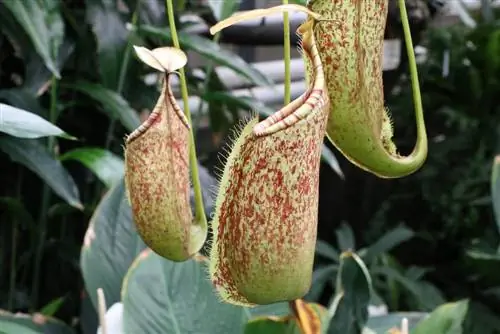
Around 100 species of pitcher plants grow in New Guinea, Malaysia and the Philippines. Nepenthes. We mainly use various hybrid varieties as houseplants. In winter they stop blooming and growing.
- Lowland pitcher plants need 20 to 30 degrees Celsius all year round, day and night
- Highland pitcher plants can stand at 10 to 16 degrees Celsius at night.
- need a lot of brightness
- Hang up a plant lamp in winter
- don’t give fertilizer
- lower water requirement than in summer
Note:
Even with good winter care, some leaves may dry up due to lack of light.
Water hoses
Water hoses catch their prey in tube-like traps, which is where they get their name from. South America and Australia are their main distribution area. There they are used to a hot climate and also to plenty of water during their vegetation phase.
Grassy bladderwort (Utricularia graminifolia)
It can be found outside of its ancestral homeland, primarily in aquariums. This carnivorous plant can also overwinter well there, without any special precautions or special care. As a swamp plant, however, it must be protected in winter because it is not hardy. The easiest way to do this is to move it to an aquarium before the first frosts and spend the winter there. As soon as frost is no longer expected, she can go back into the garden pond.
Common bladderwort (Utricularia vulgaris)
This type of water hose floats freely in the garden pond. Thanks to good winter hardiness, the plant can overwinter directly in the pond. In the fall it simply curls up into a ball and sinks to the bottom of the pond. After the winter rest, the plant simply unrolls itself again and sprouts again. This is also called gardener-friendly overwintering.
Shooting plants
They also come from far away, because Australia is their natural home. Although they do not hibernate, their care needs are lower in winter than in summer.
- If the temperature outside falls below 10 degrees Celsius, you have to go inside
- the winter location must be bright
- the water requirement is low
Tip:
If the plant is allowed out again in the summer, it should only be exposed to the sun in doses until it gets used to it again. Otherwise their leaves can burn.
Sundew
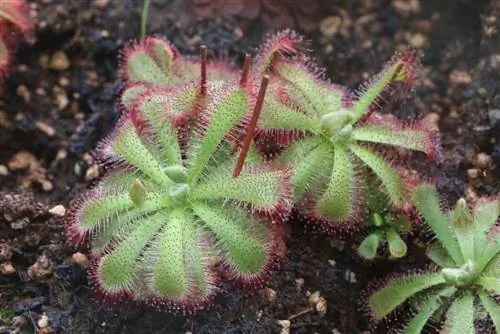
Species in this genus are numerous and native to South Africa, South America and Australia. There are both hardy and non-hardy varieties of Droserea.
Tempered species
These species are hardy and also widespread in Europe. They grow in bog beds and outdoors. They need hibernation, but require little assistance from the owner. The plant pulls them back and forms a so-called overwintering bud. As soon as it is warm enough in spring, it will sprout again.
Note:
If the water in the bog bed freezes completely, the plant can no longer absorb water and would dry up. Be careful not to let this situation happen.
Subtropical species
Subtropical species of sundew are extremely easy to cultivate, which is why we often find this species as a houseplant. In their homeland they have warm summers and cooler winters. In the summer they can stay outside here, but they have to overwinter at room temperature because our winter is much too cold for them.
- must overwinter frost-free
- Room temperature between 15 and 18 degrees Celsius
- Location with a lot of light
- no fertilizer and less water
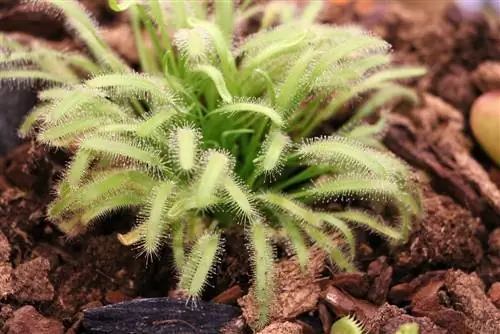
Not all species of subtropical sundews require a colder environment in winter. Some species can be overwintered at normal room temperature without any problems. These include the popular varieties Drosera aliciae and Drosera capensis. However, in the darker seasons they need a plant lamp to provide them with additional light. If they are too dark, their resistance drops and gray mold can be the undesirable result.
Note:
If the reddish leaves of the sundew turn green, this is a sign of lack of light.
Tropical Sundew
Tropical sundew species need warm temperatures, lots of brightness and direct sunlight all year round. There should be a humidity of at least 50 percent. In order for them to thrive, they still need a break. They survive the winter best at 15 to 18 degrees Celsius. It can still be bright. Only water with low-lime water, slightly less in winter.
Dwarf sundew
A terrarium with high humidity is ideal for these mini plants. It should get as much sun as possible. In winter it gets along well with a temperature of 12 to 15 degrees Celsius. During this time it requires less water.


